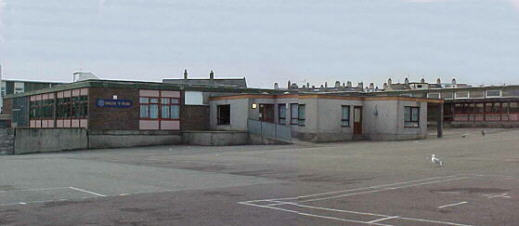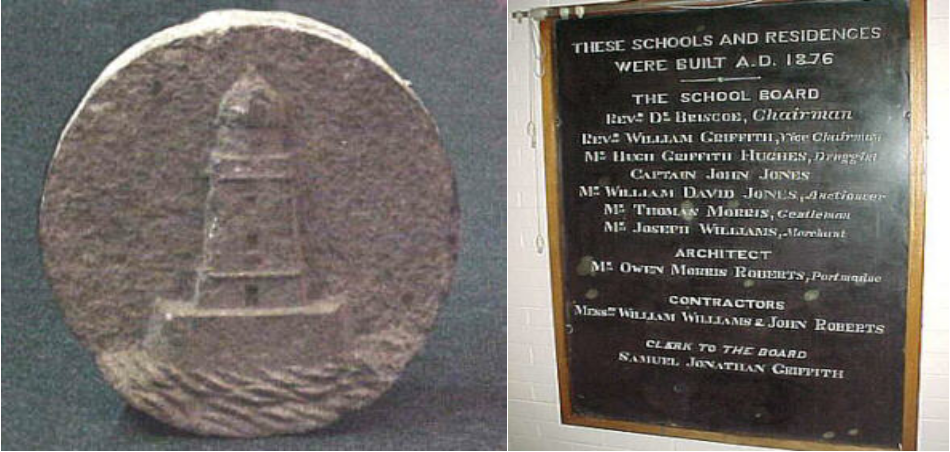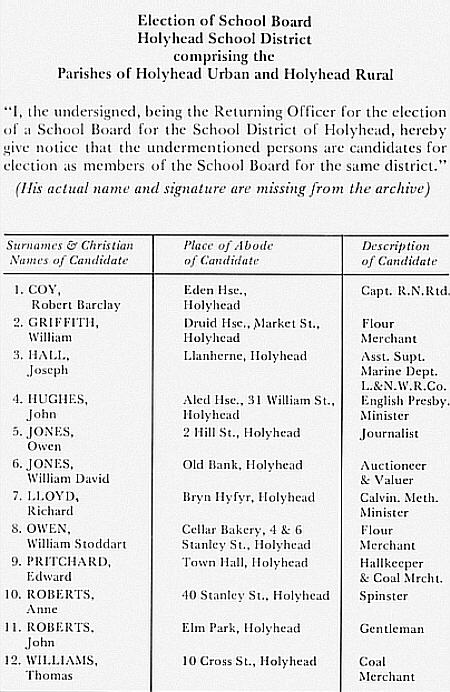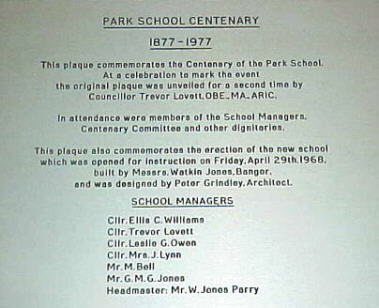

Park school gets it’s name from a popular legend that the area occupied by the school was a natural park, covered by trees. Some of the trees still remain, where the original Park school was built. Unfortunately there is no known record of any ceremony in connection with laying the first stone or the date on which building began. The school was a very impressive building, made from local granite or limestone, each stone beautifully pointed. Three of the stone clocks had a lighthouse inscribed on them and placed a strategic vantage points at the front of each school. It has never been established why the stones were engraved in this way. It is thought that it may have been to mark the connection between the materials used in building both the breakwater (which had been completed two years prior), and the school. Was is possible that the contractor who built the school also hired the stonemasons who built the breakwater – and hence the particularly high standard of craftsmanship? Upon completion of the school building a commemorate slate plaque was placed on the front of the school, naming the first board of Managers, and the contractor who had built the school. This plaque is proudly on display in the new Park School. Over the years the school earned for itself a reputation for high academic standards with certain genius, so it is alleged for producing Sea Captains. Many ex-pupils of the school have reached high positions in society. They include William Jones MP and Captain Neville Riley who was Master of the Blue Star Line the “Brisbane Star” during Operation Pedestal in 1942. Also the famous surgeon Mr. Oliver attended Park school, Professor Bryan Roberts who was appointed Chairman of Anaesthesiology at Wright State University School of Medicine, Dayton, Ohio, USA., Dr. Ken Roberts and Dr. Tudor Lloyd are also amongst the former pupils of the school.The Master informed the board on 8th September 1891 that two of the school’s pupils namely William Griffith and Arthur Bell had gained a scholarship to Beaumaris Grammar School (the only source of secondary education on the island) and that they had gone to see him on that day to say goodbye – a very proud moment. The school was opened on 19th March 1877. Headmaster of the boys’ department was Mr. Owen Roberts, whilst that of the girls department was Miss Parry of Tyddyn Bach, and in charge of the Infants’ department was 20 year old Miss Mary Jane Jones. Miss Parry was succeeded my Miss Margaret Evans. All three heads remained at the school until their retirement. Miss Gladys M. P. Jones was appointed Headmistress in 1924, and she remained there until her new appointment to Cybi School in 1929. Miss H. G. Williams succeeded her, and remained at the school until 1948. In those times the head of each department were the only qualified teachers at the school. They were helped by “pupil teachers”, candidates and monitors usually in their teenage years and possessing very little academic knowledge. The schools’ log books between the years of 1877 to 1911 refer to pupil teachers and monitors being taught by masters and mistresses during out of school hours in both academic knowledge and teaching techniques. Monitors were paid £5 per annum, and pupil teachers about £10 per annum and only rising to £14 p.a. after 4 years. This would rise to £25 p.a. after the completion of 5 years in the occupation. The headmasters and mistresses salaries were based on the quality of results and on the average school attendance. The headmaster would write daily in the school log book. He would often write about local events, and sometimes some amusing stories. The masters’ were very much more in control of their schools, than they are nowadays, as they weren’t required to account to any official bodies when making decisions regarding the school. The schools in the area were run by a local Board of elected member, all of which were of high standing in the community to see the poster announcing the election of 1895. From time to time the master of mistress of the school were summonsed to meet with the school Board, where searching questions had to be answered about their schools. The Board members also visited the schools a task they took very serious indeed. On 12th October 1888 a resolution was passed by the Board that the Welsh language be taught as a specific subject, and this was at a time when every effort was made throughout Wales to suppress the language at the height of the “Welsh not” period, as it was believed that the children throughout Wales should practice the use of the English language as it was thought to be the key to worldly success. The Board took their decisions one step further on 9th June 1899 and decided that standards 1, 2, and 3 should take the Welsh language as an ordinary class subject. The Board also played a big part in the appointment of new staff into the schools at Holyhead. In 1891 all scholars were admitted into schools – free of charge, which meant that all children could now attend school, and in 1899 it was announced that children could not be withdrawn from school until the age of 14 years. Britain were indoctrinated with ideas of glory of Queen and Empire. War efforts by the British troops was talked about with pride, and reflected in the children’s play and writing. The children practised the National Anthem in readiness for the Queen’s visit to Holyhead on 30th March 1900, on her way to Ireland, and again upon her return on 30th April. The school mourned the death of the Queen on 1st January 1901. Edward was then made King, and the school immediately began preparing for the event. The King and Queen came to Holyhead also on their way to Ireland, on 20th July 1903. Many children were encouraged to play truant, so that their parents did not have to pay the school fee. young children would walk the streets with barely sufficient clothes to cover them. On 3rd September 1908 an unnamed lady went to the school to address the pupils on behalf of Dr. Bernado’s Homes. also in 1908, the children were given a Christmas tea party by Lord Stanley of Penrhos. This they did for the children for many years. On 30th May 1904 the school Board was disbanded and replaced by a new central authority called the Anglesey Education Committee. In 1904 a visiting inspector to the school suggested that slates should no longer be used, and that exercise books should be purchased from Messrs. E. J. Arnold, at a cheap rate. This advice was not taken up until 1909 however, due to the lack of funds. Mr. Owen Roberts retired as the Head of the boys’ department on 29th August 1911, where he had served for 34 years. Mr. W. B. Thomas succeeded him. Also in 1911 was the appointment of Mr Jackson (who later became headmaster of Llaingoch school) to the school staff. 1911 also saw the institution of the “Penny Bank”. The children could save their money at the school, and up to 30 children did so. A school soccer team was also formed in 1911, with games being played on Salt Island, and the children were also encouraged to do athletics and swimming – being marched down to Newry Beach for their lessons! The new headmaster and his assistant Mr. Singleton were very enthusiastic men who encouraged the children of Park school to learn navigation and seamanship, outdoor work – with environmental excursions such as visiting Newry Beach, the stream running past the water mill at Porthyfelin, to Trearddur Bay to study geography and antiquities of that area, and much more. The good work was disrupted by the war. The headmaster was conscripted for guard duty on the Britannia Bridge, and many of the staff, drafted for National Service. Mr. Singleton lost his life, whilst serving on the RMS Leinster, which sank with the loss of 600 loves, due to an enemy submarine. In 1922, Sir Ifan Edwards founded the Urdd movement in an attempt to restore to Wales it’s language and heritage. He visited Park school on 3rd March 1927. It was not for another 40 years, however until a branch of the movement was formed at the school. Education was disrupted again during the second World War of 1939 – 1945. Mr W. B. Thomas retired in 1942, after a period of 31 years at the school. On his retirement the authorities amalgamated the boys and girls department under one head teacher. The school now comprised of two sections – Juniors and Infants and renamed “The Park Junior and Infant School”. The Junior dept taken over b Miss H. G. Williams, and Miss Hannah Owen took over the Infants Section, Miss H. G. Williams retired in 1948, and was succeeded by Mr. Cecil Roberts. A new Park school has been built in 1954 (Thomas Ellis School) with another being contemplated at Llanfawr (built 1957). The authority were planning to house all the primary school aged children at these two schools, and at Cybi School. Therefore very little repair work was done on the Park school which dilapidated quickly. It was intended to close the school. In 1957 Miss Hannah Owen retired after 23 years of service. The school was then placed in overall charge of Mr. Cecil Roberts until Mr. W. Jones Parry took his place in September 1958. In 1960 the Education Authority decided to close the Cybi school giving Park school a new lease of life. The pupils of Cybi school. One hundred new pupils were admitted. In 1966 building commenced on the Park school we know today. The new school opened its doors on 29th April 1968 with a register of 300 pupils, which increased at its peak to 360. Since then, two semi-permanent units were installed, and a new nursery wing was also built.The school celebrated its centenary in 1977, and a plaque to commemorate the event was unveiled.

CENTENARY PLAQUE

